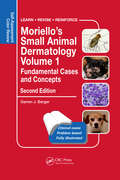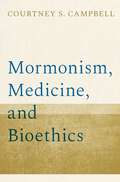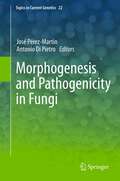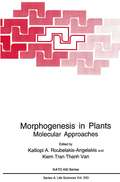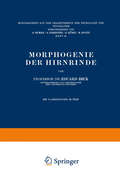- Table View
- List View
The Morehouse Model: How One School of Medicine Revolutionized Community Engagement and Health Equity
by Ronald L. Braithwaite Tabia Henry Akintobi Daniel S. Blumenthal W. Mary LangleyAmong the 154 medical schools in the United States, Morehouse School of Medicine stands out for its formidable success in improving its surrounding communities. Over its history, Morehouse has become known as an institution committed to community engagement with an interest in closing the health equity gap between people of color and the white majority population. In The Morehouse Model, Ronald L. Braithwaite and his coauthors reveal the lessons learned over the decades since the school's founding—lessons that other medical schools and health systems will be eager to learn in the hope of replicating Morehouse's success. Describing the philosophical, cultural, and contextual grounding of the Morehouse Model, they give concrete examples of it in action before explaining how to foster the collaboration between community-based organizations and university faculty that is essential to making this model of care and research work. Arguing that establishing ongoing collaborative projects requires genuineness, transparency, and trust from everyone involved, the authors offer a theory of citizen participation as a critical element for facilitating behavioral change. Drawing on case studies, exploratory research, surveys, interventions, and secondary analysis, they extrapolate lessons to advance the field of community-based participatory research alongside community health.Written by well-respected leaders in the effort to reduce health inequities, The Morehouse Model is rooted in social action and social justice constructs. It will be a touchstone for anyone conducting community-based participatory research, as well as any institution that wants to have a positive effect on its local community.
The Morehouse Mystique: Becoming a Doctor at the Nation's Newest African American Medical School
by Marybeth GasmanThe Morehouse School of Medicine in Atlanta, Georgia, is one of only four predominantly Black medical schools in the United States. Among its illustrious alumni are surgeons general of the United States, medical school presidents, and numerous other highly regarded medical professionals. This book tells the engrossing history of this venerable institution.The school was founded just after the civil rights era, when major barriers prevented minorities from receiving adequate health care and Black students were underrepresented in predominantly White medical schools. The Morehouse School of Medicine was conceived to address both problems—it was a minority-serving institution educating doctors who would practice in underserved communities.The school's history involves political maneuvering, skilled leadership, dedication to training African American physicians, and a mission of primary care in disadvantaged communities. Highlighting such influential leaders as former Health and Human Services Secretary Louis W. Sullivan, The Morehouse Mystique situates the school in the context of the history of medical education for Blacks and race relations throughout the country. The book features excerpts from personal interviews with prominent African American doctors as well as with former presidents Jimmy Carter and George H. W. Bush, who reveal how local, state, and national politics shaped the development of Black medical schools in the United States.The story of the Morehouse School of Medicine reflects the turbulent time in which it was founded and the lofty goals and accomplishments of a diverse group of African American leaders. Their tireless efforts in creating this eminent Black institution changed the landscape of medical education and the racial and ethnic makeup of physicians and health care professions.
The Morehouse Mystique: Becoming a Doctor at the Nation's Newest African American Medical School
by Marybeth GasmanThe Morehouse School of Medicine in Atlanta, Georgia, is one of only four predominantly Black medical schools in the United States. Among its illustrious alumni are surgeons general of the United States, medical school presidents, and numerous other highly regarded medical professionals. This book tells the engrossing history of this venerable institution.The school was founded just after the civil rights era, when major barriers prevented minorities from receiving adequate health care and Black students were underrepresented in predominantly White medical schools. The Morehouse School of Medicine was conceived to address both problems—it was a minority-serving institution educating doctors who would practice in underserved communities.The school's history involves political maneuvering, skilled leadership, dedication to training African American physicians, and a mission of primary care in disadvantaged communities. Highlighting such influential leaders as former Health and Human Services Secretary Louis W. Sullivan, The Morehouse Mystique situates the school in the context of the history of medical education for Blacks and race relations throughout the country. The book features excerpts from personal interviews with prominent African American doctors as well as with former presidents Jimmy Carter and George H. W. Bush, who reveal how local, state, and national politics shaped the development of Black medical schools in the United States.The story of the Morehouse School of Medicine reflects the turbulent time in which it was founded and the lofty goals and accomplishments of a diverse group of African American leaders. Their tireless efforts in creating this eminent Black institution changed the landscape of medical education and the racial and ethnic makeup of physicians and health care professions.
Moriello's Small Animal Dermatology Volume 1, Fundamental Cases and Concepts: Self-Assessment Color Review, Second Edition (Veterinary Self-Assessment Color Review Series)
by Darren BergerKaren Moriello's seminal book has been completely updated in an effort to create a true two-volume set highlighting fundamental and advanced concepts. This revised fundamental edition includes all new cases and nearly 300 new images. The guide uses a case-based format to deliver a general overview of dermatology of the dog and cat, providing a reference that mirrors the way veterinarians will encounter different scenarios at random in real-life practice. It uses self-assessment problems to review the most common skin diseases encountered every day, plus some more obscure diseases that a veterinarian will face.
Moriello's Small Animal Dermatology Volume 1, Fundamental Cases and Concepts: Self-Assessment Color Review, Second Edition (Veterinary Self-Assessment Color Review Series)
by Darren BergerKaren Moriello's seminal book has been completely updated in an effort to create a true two-volume set highlighting fundamental and advanced concepts. This revised fundamental edition includes all new cases and nearly 300 new images. The guide uses a case-based format to deliver a general overview of dermatology of the dog and cat, providing a reference that mirrors the way veterinarians will encounter different scenarios at random in real-life practice. It uses self-assessment problems to review the most common skin diseases encountered every day, plus some more obscure diseases that a veterinarian will face.
Mormonism, Medicine, and Bioethics
by Courtney S. CampbellMormonism, Medicine, and Bioethics provides the first comprehensive treatment of principles and positions on questions of bioethics encountered by members, professionals, and ecclesiastical leaders of The Church of Jesus Christ of Latter-day Saints (LDS or Mormon). The book addresses three fundamental features of a coherent religious bioethics: precepts for practical decision-making, general ethical principles, and core religious convictions that give a distinctive motivation for personal, communal, and professional integrity. LDS ethical principles of love, hospitality to strangers, covenantal solidarity, justice, and moral agency are integrated with central topics in bioethics including abortion, genetic testing and enhancements, in vitro fertilization, medical assisted death, medicinal marijuana, neonatal intensive care, organ donation, preventive health care, universal access to care, and vaccinations. This book uses first-person experiences to give voice to the lived moral realities of Latter-day Saints as they experience difficult and wrenching ethical questions and choices as persons, family members, community members, professionals, and as citizens within the context of their distinctive faith convictions. It situates these communal conversations within the broader discourse of bioethics and thereby supports both bioethics and religious literacy. Mormonism, Medicine, and Bioethics also examines circumstances in which The Church of Jesus Christ of Latter-day Saints engages in a moral witness of its values on matters of public policy, such as legalization of physician-assisted death, of elective abortion, and of medicinal marijuana. The book concludes with a distinctive normative argument on why LDS ethical principles and practices require support of universal access to an adequate level of health care for all persons. It provides an appendix of significant LDS ecclesiastical policies on medical, health, and moral issues, making it a definitive educational and reference compilation.
Mormonism, Medicine, and Bioethics
by Courtney S. CampbellMormonism, Medicine, and Bioethics provides the first comprehensive treatment of principles and positions on questions of bioethics encountered by members, professionals, and ecclesiastical leaders of The Church of Jesus Christ of Latter-day Saints (LDS or Mormon). The book addresses three fundamental features of a coherent religious bioethics: precepts for practical decision-making, general ethical principles, and core religious convictions that give a distinctive motivation for personal, communal, and professional integrity. LDS ethical principles of love, hospitality to strangers, covenantal solidarity, justice, and moral agency are integrated with central topics in bioethics including abortion, genetic testing and enhancements, in vitro fertilization, medical assisted death, medicinal marijuana, neonatal intensive care, organ donation, preventive health care, universal access to care, and vaccinations. This book uses first-person experiences to give voice to the lived moral realities of Latter-day Saints as they experience difficult and wrenching ethical questions and choices as persons, family members, community members, professionals, and as citizens within the context of their distinctive faith convictions. It situates these communal conversations within the broader discourse of bioethics and thereby supports both bioethics and religious literacy. Mormonism, Medicine, and Bioethics also examines circumstances in which The Church of Jesus Christ of Latter-day Saints engages in a moral witness of its values on matters of public policy, such as legalization of physician-assisted death, of elective abortion, and of medicinal marijuana. The book concludes with a distinctive normative argument on why LDS ethical principles and practices require support of universal access to an adequate level of health care for all persons. It provides an appendix of significant LDS ecclesiastical policies on medical, health, and moral issues, making it a definitive educational and reference compilation.
Morphin und Morphinähnlich Wirkende Verbindungen (Handbook of Experimental Pharmacology)
by O. SchaumannUm den Umfang der vorliegenden Monographie in erträglichen Grenzen zu halten und eine größere Übersichtlichkeit zu wahren, wurden von der Literatur bis zum Jahre 1940 nur diejenigen Arbeiten besprochen, die wesentliches zur Pharmakologie des Morphin beitrugen und auch heute noch Geltung besitzen. Diese Beschränkung war um so eher möglich, als in der ausgezeichneten Mono graphie von KRUEGER, EDDY und SUMWALT aus dem Jahr 1941 "The pharmacology of the opium alcaloids" die Weltliteratur bis zu diesem Zeitpunkt fast lückenlos gesammelt und kritisch besprochen worden ist. Dagegen wurde die Literatur nach 1940 bis Anfang 1957 nach Möglichkeit vollständig bearbeitet, wobei von klinischen Arbeiten allerdings nur diejenigen Berücksichtigung fanden, die für die Pharmakologie von Bedeutung sind. Das Jahr 1940 ist durch die Entdeckung der vollsynthetischen, morphinähnlich wirkenden Verbindungen ein Markstein in der Pharmakologie dieser wichtigen Therapeutica. Da infolge der fast unbegrenzten Variationsmöglichkeit der che mischen Grundtypen jetzt Hunderte von Verbindungen mit morphinähnlicher Wirkung verfügbar wurden, konnte versucht werden, gemeinsames im chemischen Aufbau und in der Pharmakodynamie herauszuarbeiten. Dabei zeigte sich, daß die schmerzstillende Wirkung nicht die einzige, vielleicht nicht einmal die wich tigste therapeutisch verwertbare Eigenschaft dieser Verbindungen ist. Deshalb wurde mit Absicht im Titel das Wort "Analgetica" vermieden und der allgemeinere Ausdruck "morphinähnlich wirkende Verbindungen" gewählt.
Morphin und Morphinähnlich Wirkende Verbindungen (Medical Radiology)
by Otto Schaumann Johannes Carl Bock Gustav V. Born Oskar Eichler Alfred Farah Arthur Heffter Wolfgang Heubner Josef SchüllerMorphinartige Analgetika und ihre Antagonisten: Chemie, Pharmakologie, Anwendung in der Anaesthesiologie und der Geburtshilfe (Anaesthesiologie und Intensivmedizin Anaesthesiology and Intensive Care Medicine #25)
by Francis F. Foldes M. Swerdlow E.S. SikerMorphine and Metastasis
by Marie-Odile ParatThis book would combine chapters written by the most qualified authors around the world whose research encompasses the effect of morphine or other opioids on tumor growth and metastasis. This includes clinicians involved in trials determining which type of post surgical pain management can minimize the risk of recurrence or metastasis, researchers working on animal models and studying the effect of morphine on tumors, and most importantly the mechanism for this effect, and lastly cell biologists. There is currently a lot of research going on trying to reconcile the pro- and anti-cancer aspects of opioids actions.
Morphinverschreibung in Europa: Hemmnisse durch traditionelle Haltungen, Nationale Regelungen und fehlendes Wissen. Ein Überblick aus Sicht ambulanter Verordner
Bei 60-70 % der Krebspatienten ist eine Behandlung chronischer Schmerzen mit starken Opioiden indiziert. Überraschenderweise reagieren die Ärzte in den Ländern der Europäischen Union mit Ausnahme derer in Großbritannien, Dänemark und Niederlanden sehr zurückhaltend und verschreiben nur selten Analgetika zur Schmerzbekämpfung. Das vorliegende Buch zeigt die unterschiedlichen nationalen Standards auf und gibt die Meinung erfahrener Allgemeinmediziner der EU zur derzeitigen Situation beim Verschreiben von Morphium wieder.
Morphodynamic Imaging in Achalasia
by Giovanni FontanellaThis book embarks on a journey never taken before, approaching the imaging of the disease of achalasia with new pathophysiological assumptions in mind, coming from the Chicago Classification of Manometric diagnosis. Using state-of-the-art, modern x-ray technology, the authors have developed a schematic and simple approach to detection, diagnosis, and patient stadiation and prognostic stratification, for radiologists, clinicians, and students. Key Features: 1. Serves as a useful guide to structured and comprehensive reporting of barium swallows, both in achalasia and other oesophageal motility disorders. 2. Allows radiologists, both specialists, and trainees, to comprehensively understand achalasia from anatomic, pathophysiologic, therapeutic points of view, allowing for exact comprehension, detection, and reporting of the radiologic hallmarks of the disease. 3. Empowers readers to diagnose and define the exact achalasia subtype in each patient, due to the specifically developed FBF score.
Morphodynamic Imaging in Achalasia
by Giovanni FontanellaThis book embarks on a journey never taken before, approaching the imaging of the disease of achalasia with new pathophysiological assumptions in mind, coming from the Chicago Classification of Manometric diagnosis. Using state-of-the-art, modern x-ray technology, the authors have developed a schematic and simple approach to detection, diagnosis, and patient stadiation and prognostic stratification, for radiologists, clinicians, and students. Key Features: 1. Serves as a useful guide to structured and comprehensive reporting of barium swallows, both in achalasia and other oesophageal motility disorders. 2. Allows radiologists, both specialists, and trainees, to comprehensively understand achalasia from anatomic, pathophysiologic, therapeutic points of view, allowing for exact comprehension, detection, and reporting of the radiologic hallmarks of the disease. 3. Empowers readers to diagnose and define the exact achalasia subtype in each patient, due to the specifically developed FBF score.
Morphofunctional and Neurochemical Aspects of the Mammalian Carotid Body (Advances in Anatomy, Embryology and Cell Biology #237)
by Nikolai E. Lazarov Dimitrinka Y. AtanasovaThis new volume of the book series Advances in Anatomy, Embryology and Cell Biology provides a complete and exhaustive overview of the morphofunctional organization of the mammalian carotid body, a polymodal chemosensory organ responsible for the maintenance of blood gas homeostasis. The authors review the state of the art of the neurochemical anatomy of carotid body´s cell populations with a special reference to their structural and neurochemical plasticity. The essential role of this organ in the generation, progression and maintenance of cardiorespiratory and metabolic diseases in humans and other mammals is presented. Finally, the book summarizes current knowledge on the stem cell niche in the mammalian carotid body and discusses its contribution to replacement cell therapy and other potential applications in translational research. This book represents an essential reading for physiologists, anatomists, cell, and developmental biologists, as well as physicians, veterinarians, and biomedical researchers.
Morphofunctional Aspects of Tumor Microcirculation
by Domenico RibattiBlood vessels of tumors display many structural and functional abnormalities. Their unusual leakiness, potential for rapid growth and remodeling, and expression of distinctive surface molecules mediate the dissemination of tumor cells in the bloodstream and maintain the tumor microenvironment. Like normal blood vessels, they consist of endothelial cells, mural cells and their enveloping basement membrane. Common features, irrespective of their origin, size and growth pattern, are absent hierarchy, formation of large-caliber sinusoidal vessels, markedly heterogeneous density, increased permeability, decreased and abnormal pericyte-endothelial cell adhesion, irregular basement membrane structure, and the incorporation of bone-marrow-derived endothelial progenitor cells in the microvasculature. A number of specific tumor endothelial markers have been identified, as well as chromosomal abnormalities. These markers may be used to deliver drugs specifically and selectively to the tumor microvasculature.
Morphogenesis and Individuation (Lecture Notes in Morphogenesis)
by Alessandro Sarti Federico Montanari Francesco GalofaroThis contributed volume aims to reconsider the concept of individuation, clarifying its articulation with respect to contemporary problems in perceptual, neural, developmental, semiotic and social morphogenesis. The authors approach the ontogenetical issue by taking into account the morphogenetic process, involving the concept of individuation proposed by Gilbert Simondon and Gilles Deleuze. The target audience primarily comprises experts in the field but the book may also be beneficial for graduate students. The challenge of the genesis and constitution of “units” has always been at the center of philosophical and scientific research. This ontogenetical issue is common to every discipline but it is articulated in different ways: in phenomenology of perception the constitution of perceptual units is at the base of gestalt field theories, in theoretical neuroscience synchronized neural assemblies are considered as correlates of conscious processes, in developmental embryogenesis the constitution of organs is the principle outcome of morphodynamic evolution while in social morphogenesis the constitution of coherent units is common to segmentary, gerarchic and functional differentiation.
Morphogenesis and Maturation of Retroviruses (Current Topics in Microbiology and Immunology #214)
by Hans-Georg KräusslichRetroviruses arguably belong to the most fascinating of all viruses because of their unusual and highly efficient mode of replication involving reverse transcription and integration of the viral genome and a complex system of transcriptional and post transcriptional regulatory mechanisms. The importance of ret roviruses as human and animal pathogens has also enhanced scientific and medical interest in this diverse group of viruses and has spurred an intensive search for novel and improved antiviral agents. More recently, analysis of retroviral replication and in particular understanding the formation and composition of the virus particle has received additional attention because of the promise of retroviral vectors as vehicles for human somatic gene therapy. Many recent advances have been made in our understanding of the molecular mechanisms governing as sembly and release of infectious retrovirus particles. This book attempts to summarize these recent developments and to provide an overview of our current knowledge on retrovirus particle formation. The individual chapters of the book deal with specific steps in the pathway of retroviral morphogenesis and maturation, starting at the time when the components of the virus have been synthesized within the infected cell and ending once the infectious virion has been released from the cell. An introductory chapter provides a comparative description of the structure and morphology of various retroviruses.
Morphogenesis and Pathogenicity in Fungi (Topics in Current Genetics #22)
by José Pérez Martín and Antonio Di PietroInfectious fungal diseases continue to take their toll in terms of human suffering and enormous economic losses. Invasive infections by opportunistic fungal pathogens are a major cause of morbidity and mortality in immuno-compromised individuals. At the same time, plant pathogenic fungi have devastating effects on crop production and human health. New strategies for antifungal control are required to meet the challenges posed by these agents, and such approaches can only be developed through the identification of novel biochemical and molecular targets. However, in contrast to bacterial pathogens, fungi display a wealth of “lifestyles” and modes of infection. This diversity makes it extremely difficult to identify individual, evolutionarily conserved virulence determinants and represents a major stumbling block in the search for common antifungal targets. In order to activate the infection programme, all fungal pathogens must undergo appropriate developmental transitions that involve cellular differentiation and the introduction of a new morphogenetic programme. How growth, cell cycle progression and morphogenesis are co-ordinately regulated during development has been an active area of research in fungal model systems such as budding and fission yeast. By contrast, we have only limited knowledge of how these developmental processes shape fungal pathogenicity, or of the role of the cell cycle and morphogenesis regulators as true virulence factors. This book combines state-of-the-art expertise from diverse pathogen model systems to update our current understanding of the regulation of fungal morphogenesis as a key determinant of pathogenicity in fungi.
Morphogenesis and Pattern Formation in Biological Systems: Experiments and Models
by T. Sekimura S. Noji N. Ueno Philip MainiA central goal of biology is to decode the mechanisms that underlie the processes of morphogenesis and pattern formation. Concerned with the analysis of those phenomena, this book integrates experimental and theoretical aspects of biology for the construction and investigation of models of complex processes. It offers an interdisciplinary approach to the pattern formation problems and provides a scope of forthcoming integrated biology including experiments and theories.
Morphogenesis in Plants: Molecular Approaches (Nato Science Series A: #253)
by Kalliopi A. Roubelakis-Angelakis Kiem Tran Kiem Tran Thanh VanProceedings of a NATO ASI held in Crete, Greece, September 5-17, 1992.
Morphogenesis of Thyroid Follicles in Vitro (Advances in Anatomy, Embryology and Cell Biology #52/2)
by P. Cau M. Michel-Bechet G. FayetThe thyroid gland first appears in the phylogenic scale in the Lamprey larva, Ammocoetes, at the time of metamorphosis (see review by Constantinescu, 1972). In higher Vertebrates the adult thyroid gland consists of vesicles i. e. thyroid follicles containing colloid and lined with a cubic or prismatic epithelium. Since the end of the 19th century, many authors have studied the morphoge nesis of the follicles during the embryonic and fetal development of the gland in Man and other species, principally Chick, Rat and Rabbit. The development of techniques for culturing organs of higher animals, in particular the thyroid by Carrel and Burrows (1910) and Champy (1914, 1915), allowed the study of the survival in vivo or in vitro of grafts or explants of thyroid gland obtained from adult or fetal animals. In addition to organotypic cultures, techniques for culturing cell suspensions obtained by enzymatic dissociation have recently been refined. Moreover, histological examination of pathological human glands and adult thyroids experimentally stimulated by thyrotropin hormone (TSH) has provided additional data for the understanding of thyroid follicle morphogenesis.
Morphogenie der Hirnrinde (Monographien aus dem Gesamtgebiete der Neurologie und Psychiatrie #69)
by Eduard BeckDieser Buchtitel ist Teil des Digitalisierungsprojekts Springer Book Archives mit Publikationen, die seit den Anfängen des Verlags von 1842 erschienen sind. Der Verlag stellt mit diesem Archiv Quellen für die historische wie auch die disziplingeschichtliche Forschung zur Verfügung, die jeweils im historischen Kontext betrachtet werden müssen. Dieser Titel erschien in der Zeit vor 1945 und wird daher in seiner zeittypischen politisch-ideologischen Ausrichtung vom Verlag nicht beworben.
Morphological and Cellular Aspects of Tail and Limb Regeneration in Lizards: A Model System With Implications for Tissue Regeneration in Mammals (Advances in Anatomy, Embryology and Cell Biology #207)
by Lorenzo AlibardiThe present review covers a very neglected field in regeneration studies, namely, tissue and organ regeneration in reptiles, especially represented by the lizard model of regeneration. The term “regeneration” is intended here as “the ability of an adult organism to recover damaged or completely lost body parts or organs.” The process of recovery is further termed “restitutive regeneration” when the lost part is reformed and capable of performing the complete or partial physiological activity performed by the original, lost body part. Lizards represent the only amniotes that at the same time show successful organ regeneration, in the tail, and organ failure, in the limb (Marcucci 1930a, b; Simpson 1961, 1970, 1983). This condition offers a unique opportunity to study at the same time mechanisms that in different regions of the same animal control the success or failure of regeneration. The lizard model is usually neglected in the literature despite the fact that the lizard is an amniote with a basic histological structure similar to that of mammals, and it is therefore a better model than the salamander (an a- mniote) model to investigate regeneration issues.


